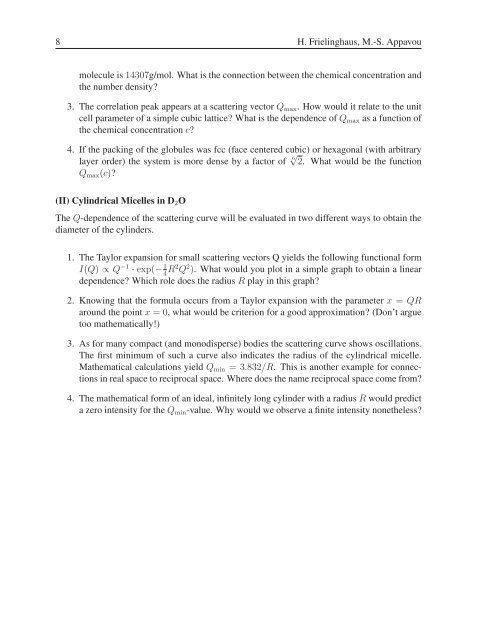Neutron Scattering - JUWEL - Forschungszentrum Jülich
Neutron Scattering - JUWEL - Forschungszentrum Jülich
Neutron Scattering - JUWEL - Forschungszentrum Jülich
Create successful ePaper yourself
Turn your PDF publications into a flip-book with our unique Google optimized e-Paper software.
8 H. Frielinghaus, M.-S. Appavou<br />
molecule is 14307g/mol. What is the connection between the chemical concentration and<br />
the number density?<br />
3. The correlation peak appears at a scattering vector Qmax. How would it relate to the unit<br />
cell parameter of a simple cubic lattice? What is the dependence of Qmax as a function of<br />
the chemical concentration c?<br />
4. If the packing of the globules was fcc (face centered cubic) or hexagonal (with arbitrary<br />
layer order) the system is more dense by a factor of 6√ 2. What would be the function<br />
Qmax(c)?<br />
(II) Cylindrical Micelles in D2O<br />
The Q-dependence of the scattering curve will be evaluated in two different ways to obtain the<br />
diameter of the cylinders.<br />
1. The Taylor expansion for small scattering vectors Q yields the following functional form<br />
I(Q) ∝ Q−1 · exp(− 1<br />
4R2Q2 ). What would you plot in a simple graph to obtain a linear<br />
dependence? Which role does the radius R play in this graph?<br />
2. Knowing that the formula occurs from a Taylor expansion with the parameter x = QR<br />
around the point x =0, what would be criterion for a good approximation? (Don’t argue<br />
too mathematically!)<br />
3. As for many compact (and monodisperse) bodies the scattering curve shows oscillations.<br />
The first minimum of such a curve also indicates the radius of the cylindrical micelle.<br />
Mathematical calculations yield Qmin =3.832/R. This is another example for connections<br />
in real space to reciprocal space. Where does the name reciprocal space come from?<br />
4. The mathematical form of an ideal, infinitely long cylinder with a radius R would predict<br />
a zero intensity for the Qmin-value. Why would we observe a finite intensity nonetheless?

















